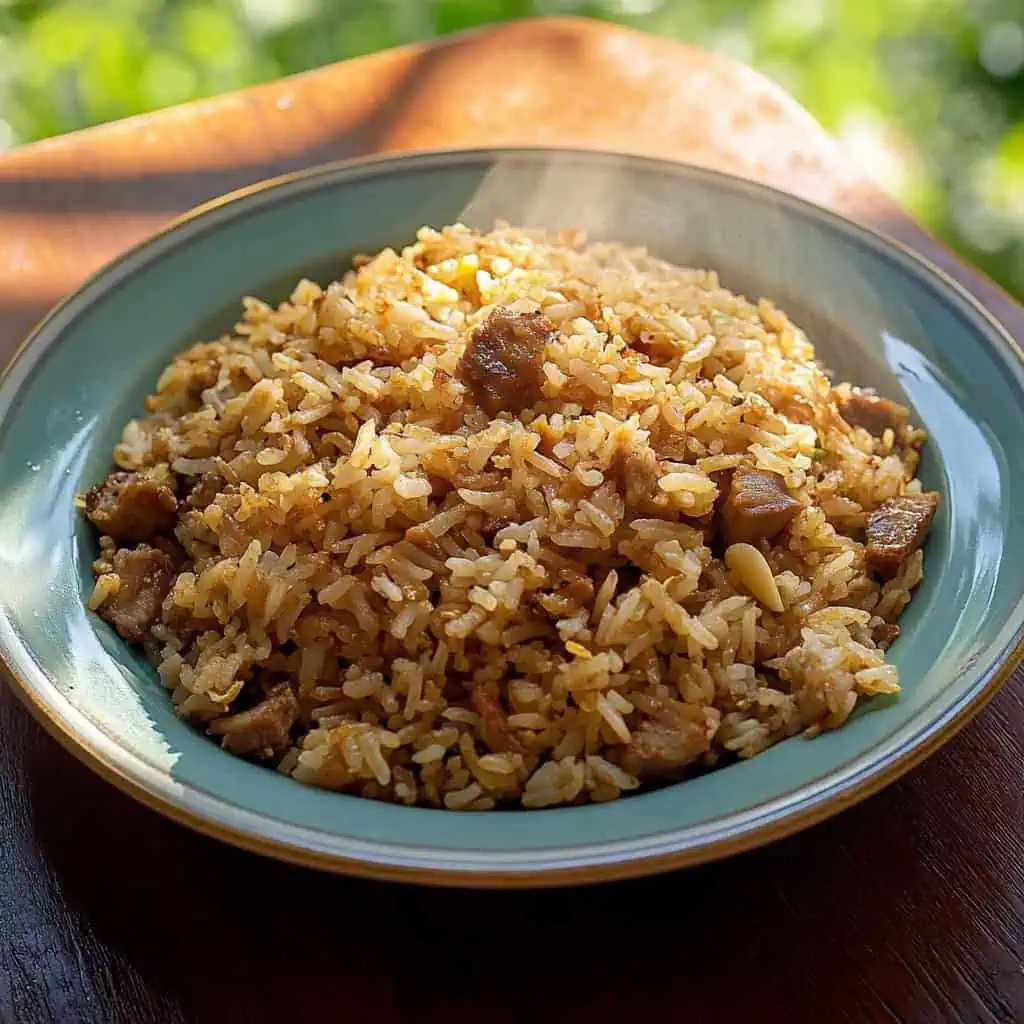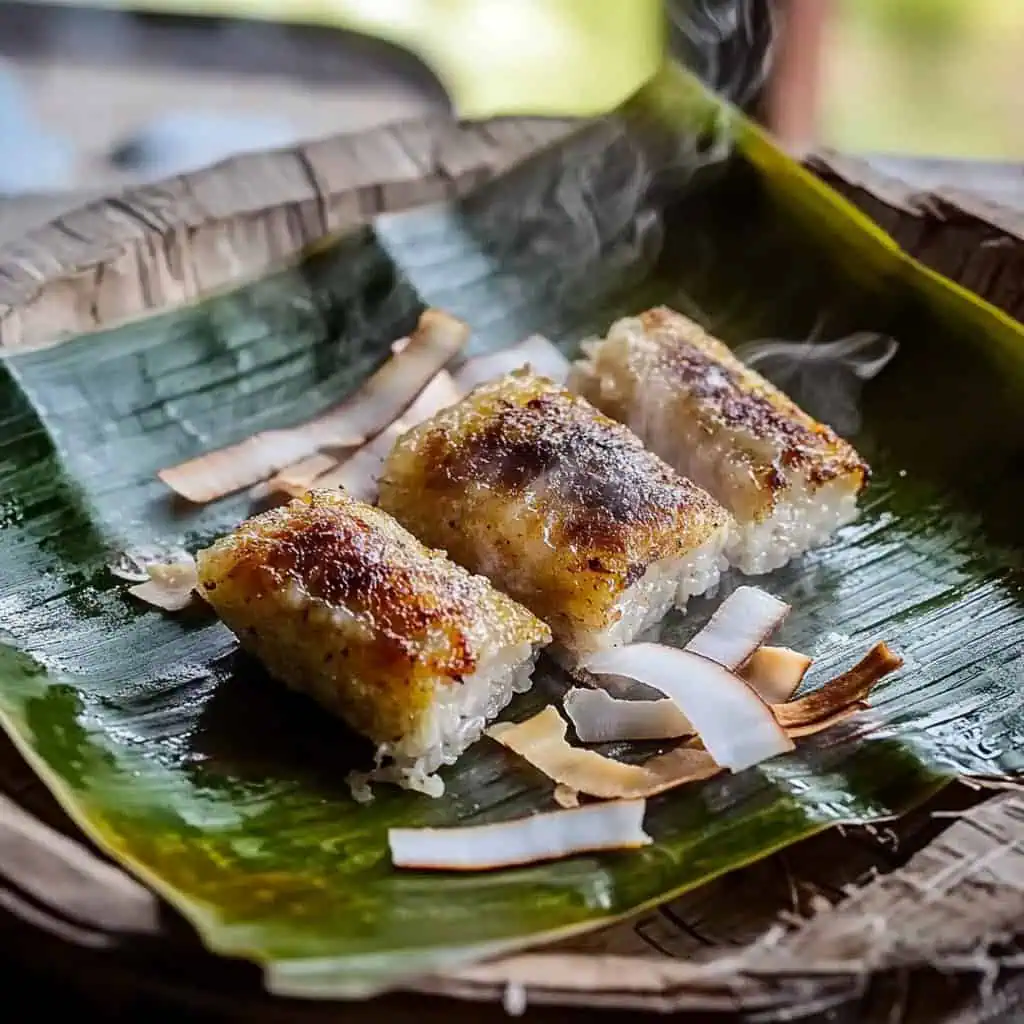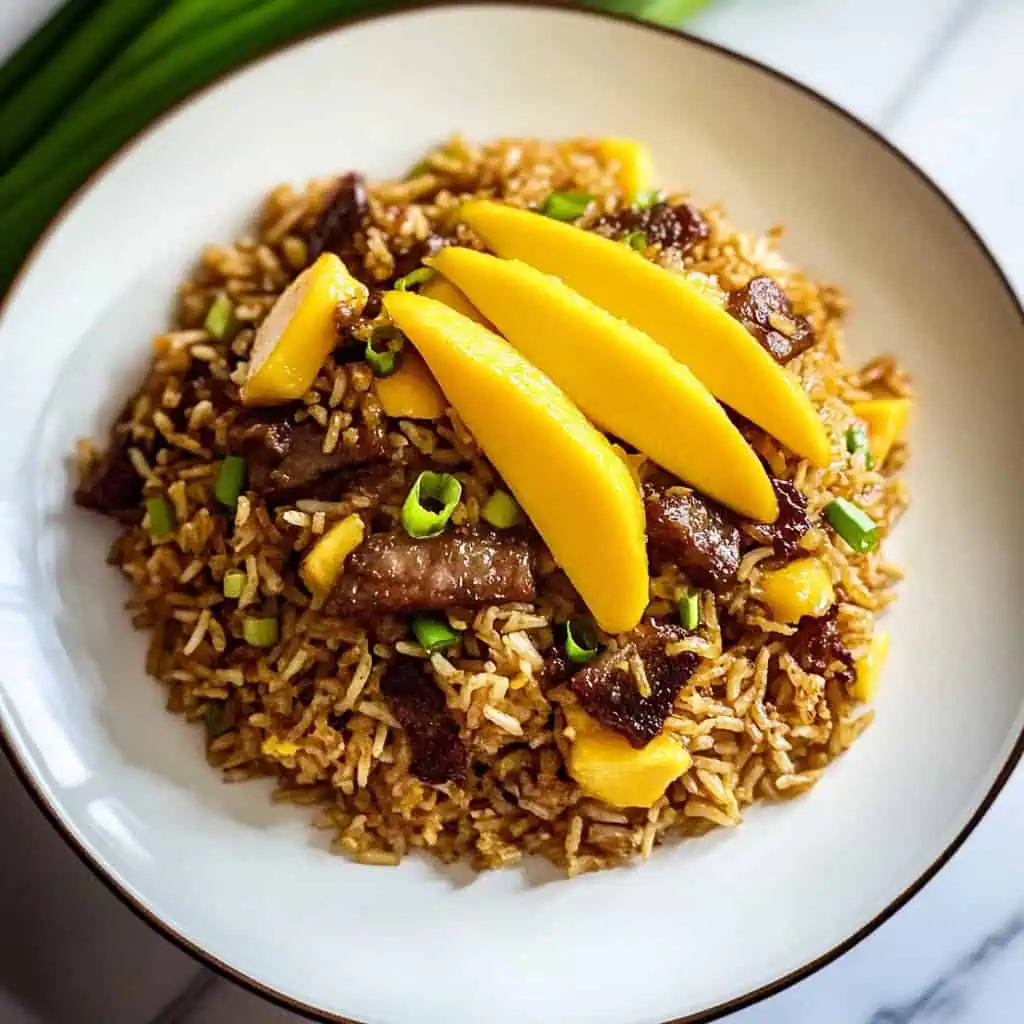You know that moment when you wake up craving something that hits all the right spots - savory, garlicky, and deeply satisfying? That's exactly what this Adobo Fried Rice does for me every single morning it graces my breakfast table.
I absolutely love how it transforms last night's adobo into something delicious. Those tender pieces of pork mingling with perfectly crispy rice, all infused with that unmistakable garlic aroma that fills the entire kitchen. It's my go-to comfort breakfast that makes me excited to get out of bed, especially when topped with a runny egg that creates this heavenly sauce when it breaks and mingles with the rice.
What is Adobo Fried Rice?
Adobo Fried Rice is a resourceful Filipino breakfast dish that combines leftover pork adobo with garlic-infused fried rice. The dish marries the complex flavors of adobo - vinegar, soy sauce, and garlic - with the satisfying texture of perfectly fried rice. By repurposing yesterday's adobo and rice, this 20-minute recipe creates a harmonious blend where tender pieces of savory pork complement the aromatic, crispy-edged rice. It represents the Filipino tradition of creative cooking, where leftovers are transformed into something equally, if not more, delightful than the original dish.
Jump to:

Why You'll Love This Recipe
- Perfect way to repurpose leftover adobo and rice
- Ready in just 20 minutes
- Packed with authentic Filipino flavors
- One-pan meal for easy cleanup
- Customizable with different proteins
- Great for meal prep
- Budget-friendly
- Satisfying comfort food
Ingredients
This recipe brings together simple ingredients that create powerful flavor. Day-old rice provides the perfect texture that won't turn mushy. Leftover adobo contributes rich, tangy-savory notes while maximizing your food budget. The abundant garlic forms the aromatic foundation that Filipinos love in fried rice.
Green onions add freshness and color, balancing the rich flavors. The optional egg topping transforms this dish from a side to a complete meal, with its runny yolk creating a natural sauce that coats each grain of rice.

- 4 cups leftover white rice, preferably day-old
- 1 cup leftover pork adobo, chopped into small pieces
- 1 whole head garlic, crushed and minced
- 3 tablespoons cooking oil
- ¼ cup green onions, finely chopped
- Salt and ground black pepper to taste
Optional Toppings:
- Fried egg
- Crushed garlic chips
- Additional chopped green onions
- Fried garlic oil
Equipment
- Large wok or deep frying pan (kawali) - For even heat distribution and easy tossing of ingredients
- Wooden or metal spatula (sandok) - For stirring without breaking the rice grains
- Cutting board (sangkalan) - For safely chopping ingredients
- Sharp knife (kutsilyo) - For mincing garlic and cutting meat into bite-sized pieces
- Measuring cups (panukat) - For accurate ingredient portions
- Small bowls (mangkok) - For organizing prepared ingredients before cooking

How To Make
- Before you start cooking, make sure you have all your ingredients prepared. Crush and mince a whole head of garlic. Chop your leftover pork adobo into bite-sized pieces. Slice the green onions finely.
- Heat your cooking oil in a large wok or deep pan over medium heat. Wait until the oil is hot - you'll know it's ready when a small piece of garlic sizzles gently when dropped in.
- Add your minced garlic to the hot oil. Cook until it turns a light golden brown and smells fragrant, about 2-3 minutes. Don't let it get too dark or it will taste bitter.
- Add your chopped adobo to the garlic. Stir and cook for just 1 minute to warm it through. Since the meat is already cooked, we're just heating it up and letting it release its flavors into the oil.
- Add your rice to the pan. If there are any clumps, break them up with your spatula. Day-old rice works best here because it's drier and will fry better. Cook for 3-5 minutes, making sure to toss the rice every minute so it doesn't stick to the pan.
- Season with salt and pepper to taste. Remember that your adobo already has salt from its sauce, so start with a little and add more if needed. If you want more flavor, you can add a spoonful of the adobo sauce.
- Add your sliced green onions and give everything a final toss. The green onions should stay bright and slightly crispy.
- Serve your adobo fried rice right away while it's hot. If you'd like, top it with a fried egg - the runny yolk makes a delicious sauce when mixed with the hot rice.
- For extra flavor, you can drizzle some of the garlic-infused oil from cooking over the top and sprinkle with extra green onions. Serve with a small bowl of vinegar with chilies on the side if you like it spicy.
- Let it cool just enough to eat comfortably, but enjoy while the rice is still steaming hot. Best served with hot coffee or Filipino hot chocolate for a true Filipino breakfast experience.

Tips from Lola's Kitchen
- "Patuyuin muna ang kanin!" (Let rice dry first!) - Use day-old rice that's been refrigerated. If you only have fresh rice, spread it on a baking sheet and let it cool completely before using.
- Maximize garlic flavor - Crush garlic cloves with the side of your knife before mincing. This releases more oils and creates a stronger flavor base for your fried rice.
- Perfect frying technique - Don't overcrowd the pan. If doubling the recipe, cook in batches to ensure each grain of rice gets crispy.
- Create "tutong" texture - For that desirable crispy rice bottom, allow the rice to sit undisturbed for 30 seconds at a time before tossing.
- Secret flavor boost - Reserve 1-2 tablespoons of the adobo sauce and add it directly to the rice for enhanced flavor distribution.
- Proper tossing technique - Use a flicking motion with your wrist rather than stirring to prevent rice from breaking and becoming mushy.
- Layered seasoning - Taste as you go. Add salt gradually since the adobo already contains significant flavor.
- Prep ahead - Chop all ingredients before heating the pan for a smooth cooking experience without burning anything.
Substitutions
- Protein options: Use chicken adobo, beef adobo, or even tofu adobo for vegetarian versions.
- Rice alternatives: Brown rice works well but may require slightly more oil. For a low-carb option, try cauliflower rice (reduce cooking time to 2-3 minutes).
- Garlic substitution: In an emergency, substitute 1 tablespoon of garlic powder, though fresh is strongly preferred for authentic flavor.
- Green onion alternatives: Chives or finely diced regular onions can work, though they'll provide a stronger flavor.
- Oil options: Coconut oil adds an authentic Filipino flavor profile, while sesame oil creates an interesting fusion twist.
- Flavor enhancers: If you don't have adobo sauce left, a mixture of 1 teaspoon soy sauce and a few drops of vinegar can help simulate the flavor.
Troubleshooting
- Rice too sticky? Add a bit more oil and spread the rice out in the pan to create more surface area for moisture to evaporate. Continue cooking at medium-high heat.
- Too dry? Add a splash of adobo sauce or a tablespoon of water and quickly toss to distribute moisture without making it soggy.
- Lacking flavor? Add more minced garlic or a dash of patis (fish sauce) to enhance the savory notes.
- Rice clumping together? Make sure to break up all clumps before adding to the pan, and use higher heat to quickly sear the outside of each grain.
- Burning too quickly? Your heat is too high. Lower it to medium and add a touch more oil to provide a buffer.
- Flavors not melding? Let the finished rice sit covered for 1-2 minutes off heat to allow flavors to develop before serving.
Storage & Reheating
- Refrigeration: Store in an airtight container in the refrigerator for up to 3 days.
- Freezing: Portion into individual servings and freeze for up to 1 month. Let thaw in the refrigerator overnight before reheating.
- Microwave reheating: Sprinkle with a few drops of water, cover loosely, and heat for 1-2 minutes, stirring halfway through.
- Skillet reheating (preferred method): For the best texture, reheat in a hot pan with a small amount of oil. This restores the crispy edges that make fried rice special.
- Flavor refresh: Add a sprinkle of freshly chopped green onions after reheating to brighten the flavors.

FAQ
Can I use freshly cooked rice?
While day-old rice is ideal because its drier texture fries better, you can use fresh rice in a pinch. Spread it on a baking sheet to cool and dry for 30 minutes before using, or cook it with slightly less water than normal.
How do I prevent the rice from sticking to the pan?
Use sufficient oil, make sure your pan is hot before adding the rice, and don't stir constantly - allow it to sizzle for brief periods before tossing.
What's the best adobo to use for this recipe?
Traditional pork or chicken adobo works best. Slightly dry adobo with concentrated flavor is preferable to very saucy versions, though you can always reduce extra sauce before adding to the rice.
Is this recipe suitable for meal prep?
Yes! It reheats well and actually develops more flavor after a day in the refrigerator. Just store in airtight containers and reheat thoroughly when ready to eat.
How can I make this dish healthier?
Use brown rice instead of white, increase the vegetable content by adding bell peppers and carrots, and consider using leaner protein like chicken adobo instead of pork.
Can I add vegetables to this recipe?
Absolutely! Frozen peas, diced carrots, bell peppers, or corn make excellent additions. Add them after the garlic but before the rice to ensure they cook through.
What makes the perfect egg topping?
A sunny-side-up egg with a runny yolk is traditional. Cook it in a separate pan while your rice finishes, and slide it directly on top of the hot rice just before serving.
Related
Looking for other recipes like this? Try these:

Filipino Adobo Fried Rice Recipe
Equipment
- Large wok or deep frying pan (kawali) For even heat distribution and easy tossing
- Wooden or metal spatula (sandok) For stirring without breaking the rice
- Cutting board (Sangkalan) For chopping ingredients
- Sharp knife (kutsilyo) For mincing garlic and cutting meat
- Measuring cups (panukat) For accurate portions
- Small bowls (mangkok) For organizing prepared ingredients
Ingredients
For the Base:
- 4 cups leftover white rice kanin, preferably day-old
- 1 cup leftover pork adobo adobong baboy, chopped into small pieces
- 1 whole head garlic bawang, crushed and minced
- 3 tablespoons cooking oil
- ¼ cup green onions dahon ng sibuyas, finely chopped
- Salt asin and ground black pepper (paminta) to taste
Optional Toppings:
- Fried egg pritong itlog
- Crushed garlic chips tostadong bawang
- Additional chopped green onions
- Fried garlic oil mantika ng bawang
Instructions
- Before you start cooking, make sure you have all your ingredients prepared. Crush and mince a whole head of garlic. Chop your leftover pork adobo into bite-sized pieces. Slice the green onions finely.
- Heat your cooking oil in a large wok or deep pan over medium heat. Wait until the oil is hot - you'll know it's ready when a small piece of garlic sizzles gently when dropped in.
- Add your minced garlic to the hot oil. Cook until it turns a light golden brown and smells fragrant, about 2-3 minutes. Don't let it get too dark or it will taste bitter.
- Add your chopped adobo to the garlic. Stir and cook for just 1 minute to warm it through. Since the meat is already cooked, we're just heating it up and letting it release its flavors into the oil.
- Add your rice to the pan. If there are any clumps, break them up with your spatula. Day-old rice works best here because it's drier and will fry better. Cook for 3-5 minutes, making sure to toss the rice every minute so it doesn't stick to the pan.
- Season with salt and pepper to taste. Remember that your adobo already has salt from its sauce, so start with a little and add more if needed. If you want more flavor, you can add a spoonful of the adobo sauce.
- Add your sliced green onions and give everything a final toss. The green onions should stay bright and slightly crispy.
- Serve your adobo fried rice right away while it's hot. If you'd like, top it with a fried egg - the runny yolk makes a delicious sauce when mixed with the hot rice.
- For extra flavor, you can drizzle some of the garlic-infused oil from cooking over the top and sprinkle with extra green onions. Serve with a small bowl of vinegar with chilies on the side if you like it spicy.
- Let it cool just enough to eat comfortably, but enjoy while the rice is still steaming hot. Best served with hot coffee or Filipino hot chocolate for a true Filipino breakfast experience.
Tips from Lola's Kitchen
- "Patuyuin muna ang kanin!" (Let rice dry first!) - Use day-old rice or spread freshly cooked rice on a tray to cool and dry
- Crush garlic with the side of your knife before mincing for better flavor release
- Don't overcrowd the pan - cook in batches if needed
- Keep the heat medium-high for that perfect "tutong" (crispy rice bottom)
- Save some adobo sauce to mix with the rice for extra flavor
Nutrition
The Story Behind Adobo Fried Rice
The story of Adobo Fried Rice beautifully illustrates the Filipino spirit of resourcefulness and culinary creativity. This beloved breakfast dish emerged from the practical need to transform leftover adobo, the Philippines' unofficial national dish, into something equally memorable for the next day's meal. While traditional adobo dates back to pre-colonial times, when vinegar and salt were used to preserve meat in the tropical climate, this innovative fried rice variation likely developed in Filipino home kitchens during the mid-20th century.
In Filipino households, rice is considered sacred - throwing away leftover rice is traditionally seen as disrespectful to the bounty of nature. This reverence, combined with the popularity of adobo, naturally led to the creation of Adobo Fried Rice. The dish perfectly embodies the Filipino concept of "sayang" - the mindful avoidance of waste. Home cooks discovered that the rich, complex flavors of adobo's vinegar-soy sauce mixture could transform simple garlic fried rice (sinangag) into something extraordinary.
The genius of Adobo Fried Rice lies in how it amplifies the already beloved flavors of traditional adobo. When chopped adobo meat is fried with day-old rice, its concentrated flavors infuse every grain. The garlic, a crucial element in both adobo and sinangag, creates a harmonious bridge between the two dishes. This combination has become so popular that some Filipino restaurants now deliberately make extra adobo just to serve this fried rice variation the next day.
Today, Adobo Fried Rice has evolved beyond being merely a way to use leftovers. It's become a sought-after dish in its own right, particularly beloved during breakfast alongside a perfectly fried egg - creating what many consider the ultimate Filipino breakfast experience. The dish showcases how Filipino cuisine often finds its greatest expressions not just in traditional recipes, but in the creative ways home cooks reinvent and repurpose classic dishes. Whether served in humble carinderias or upscale Filipino restaurants, Adobo Fried Rice represents the continuing evolution of Filipino culinary traditions.
Modern Filipino families have embraced this dish not just for breakfast but as an all-day meal option. Its popularity has spread beyond Philippine shores, with Filipino restaurants worldwide featuring it on their menus. The dish perfectly embodies the Filipino talent for transforming humble leftovers into something new and exciting - a delicious testament to the sustainability and creativity inherent in Filipino cooking culture.










Comments
No Comments